Related Research Articles

Enlil, later known as Elil and Ellil, is an ancient Mesopotamian god associated with wind, air, earth, and storms. He is first attested as the chief deity of the Sumerian pantheon, but he was later worshipped by the Akkadians, Babylonians, Assyrians, and Hurrians. Enlil's primary center of worship was the Ekur temple in the city of Nippur, which was believed to have been built by Enlil himself and was regarded as the "mooring-rope" of heaven and earth. He is also sometimes referred to in Sumerian texts as Nunamnir. According to one Sumerian hymn, Enlil himself was so holy that not even the other gods could look upon him. Enlil rose to prominence during the twenty-fourth century BC with the rise of Nippur. His cult fell into decline after Nippur was sacked by the Elamites in 1230 BC and he was eventually supplanted as the chief god of the Mesopotamian pantheon by the Babylonian national god Marduk.

Gilgamesh was a hero in ancient Mesopotamian mythology and the protagonist of the Epic of Gilgamesh, an epic poem written in Akkadian during the late 2nd millennium BC. He was possibly a historical king of the Sumerian city-state of Uruk, who was posthumously deified. His rule probably would have taken place sometime in the beginning of the Early Dynastic Period, c. 2900 – 2350 BC, though he became a major figure in Sumerian legend during the Third Dynasty of Ur.
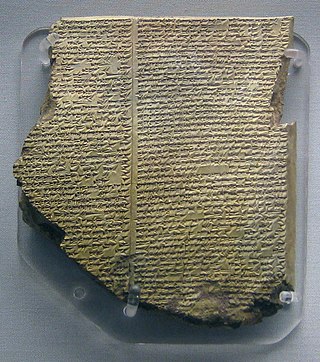
The Epic of Gilgamesh is an epic poem from ancient Mesopotamia. The literary history of Gilgamesh begins with five Sumerian poems about Gilgamesh, king of Uruk, some of which may date back to the Third Dynasty of Ur. These independent stories were later used as source material for a combined epic in Akkadian. The first surviving version of this combined epic, known as the "Old Babylonian" version, dates back to the 18th century BC and is titled after its incipit, Shūtur eli sharrī. Only a few tablets of it have survived. The later Standard Babylonian version compiled by Sîn-lēqi-unninni dates to somewhere between the 13th to the 10th centuries BC and bears the incipit Sha naqba īmuru. Approximately two-thirds of this longer, twelve-tablet version have been recovered. Some of the best copies were discovered in the library ruins of the 7th-century BC Assyrian king Ashurbanipal.
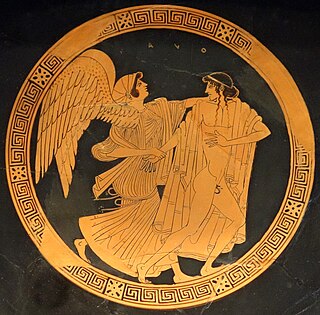
In Greek mythology, Tithonus was the lover of Eos, Goddess of the Dawn. He was a prince of Troy, the son of King Laomedon by the Naiad Strymo (Στρυμώ). The mythology reflected by the fifth-century vase-painters of Athens envisaged Tithonus as a rhapsode, as attested by the lyre in his hand, on an oinochoe of the Achilles Painter, circa 470–460 BC.

Ziusudra of Shuruppak is listed in the WB-62 Sumerian King List recension as the last king of Sumer prior to the Great Flood. He is subsequently recorded as the hero of the Eridu Genesis and appears in the writings of Berossus as Xisuthros.

Mahavatar Babaji is the Himalayan yogi and guru who taught Kriya Yoga to Lahiri Mahasaya (1828–1895). Babaji first became recognized through the writings of Paramahansa Yogananda, who devoted a chapter of his Autobiography of a Yogi to Babaji and founded Self-Realization Fellowship, a modern yoga movement that Babaji is associated with. The cave near Ranikhet where Babaji met Lahiri Mahasaya is now a tourist attraction and place of pilgrimage in India.

Kriya Yoga is a yoga system which consists of a number of levels of pranayama, mantra, and mudra, intended to rapidly accelerate spiritual development and engender a profound state of tranquility and God-communion. It is described by its practitioners as an ancient yoga system revived in modern times by Lahiri Mahasaya, who claimed to be initiated by a guru, Mahavatar Babaji, circa 1861 in the Himalayas. Kriya Yoga was brought to international awareness by Paramahansa Yogananda's book Autobiography of a Yogi and through Yogananda's introductions of the practice to the West from 1920.

Enkidu (Sumerian: 𒂗𒆠𒄭EN.KI.DU10) was a legendary figure in ancient Mesopotamian mythology, wartime comrade and friend of Gilgamesh, king of Uruk. Their exploits were composed in Sumerian poems and in the Akkadian Epic of Gilgamesh, written during the 2nd millennium BC. He is the oldest literary representation of the wild man, a recurrent motif in artistic representations in Mesopotamia and in Ancient Near East literature. The apparition of Enkidu as a primitive man seems to be a potential parallel of the Old Babylonian version (1300–1000 BC), in which he was depicted as a servant-warrior in the Sumerian poems.
Al-Khidr is a figure not mentioned by name in the Quran. He is described in Surah Al-Kahf, as a righteous servant of God possessing great wisdom or mystic knowledge. In various Islamic and non-Islamic traditions, Khidr is described as an angel, prophet, or wali, who guards the sea, teaches secret knowledge and aids those in distress. He prominently figures as patron of the Islamic saint ibn Arabi. The figure of al-Khidr has been syncretized over time with various other figures including Dūraoša and Sorūsh in Iran, Sargis the General and Saint George in Asia Minor and the Levant, Samael in Judaism, Elijah among the Druze, John the Baptist in Armenia, and Jhulelal in Sindh and Punjab in South Asia. He is commemorated on the holiday of Hıdırellez.

The elixir of life, also known as elixir of immortality, is a potion that supposedly grants the drinker eternal life and/or eternal youth. This elixir was also said to cure all diseases. Alchemists in various ages and cultures sought the means of formulating the elixir.

The Cedar Forest is the glorious realm of the gods of Mesopotamian mythology. It is guarded by the demigod Humbaba and was once entered by the hero Gilgamesh who dared cut down trees from its virgin stands during his quest for fame. The Cedar Forest is described in Tablets 4–6 of the Epic of Gilgamesh. Earlier descriptions come from the Ur III poem Gilgamesh and Huwawa.

Haidakhan Babaji, simply called Babaji by his students and devotees, was a religious teacher who appeared near the village of Haidakhan in northern India (Uttarakhand) and taught publicly from 1970 until his death in 1984. He has a following in the Western world, and two ashrams in India.

The Epic of Gilgamesh has directly inspired many manifestations of literature, art, music, and popular culture throughout history. It was extremely influential during the Bronze Age and Iron Age in the Middle East, but gradually fell into obscurity during classical antiquity. The story was rediscovered in the 19th century, and began to regain popular recognition and influence in the 20th century.

The Gilgamesh flood myth is a flood myth in the Epic of Gilgamesh. It is one of three Mesopotamian Flood Myths alongside the one including in the Eridu Genesis, and an episode from the Atra-Hasis Epic. Many scholars believe that the flood myth was added to Tablet XI in the "standard version" of the Gilgamesh Epic by an editor who used the flood story from the Epic of Atra-Hasis. A short reference to the flood myth is also present in the much older Sumerian Gilgamesh poems, from which the later Babylonian versions drew much of their inspiration and subject matter.
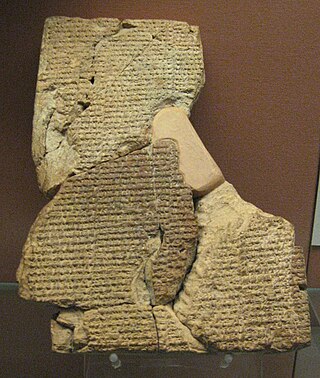
Uta-napishtim, was a legendary king of the ancient city of Shuruppak in southern Iraq, who, according to several surviving narratives, survived the Flood by making a boat.
Eridu Genesis, also called the Sumerian Creation Myth, Sumerian Flood Story and the Sumerian Deluge Myth, offers a description of the story surrounding how humanity was created by the gods, how the office of kingship entered human civilization, the circumstances leading to the origins of the first cities, and the global flood.
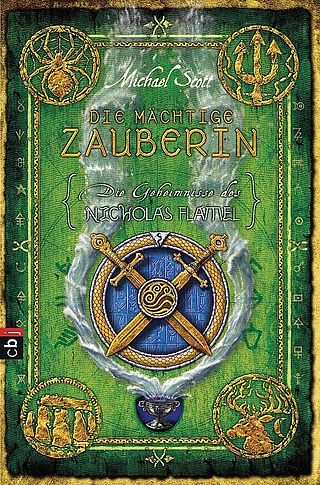
The Sorceress: The Secrets of the Immortal Nicholas Flamel is a fantasy novel and the third installment in the six-book series The Secrets of the Immortal Nicholas Flamel written by Michael Scott. It serves as the sequel to The Magician, and was released on 26 May 2009 in the US, 1 June 2009 in Australia, and 25 June 2009 in the UK. The titular sorceress refers to Perenelle Flamel.

Diana and Endymion is a painting by Francesco Solimena undertaken from 1705 until 1710. The painting depicts the Roman goddess Diana, one of the twelve Gods and Goddesses of Olympus, falling in love with Endymion, a symbol of timeless beauty. The story tells of Diana's love for the beautiful youth Endymion. The painting is hosted at the National Museums Liverpool, that purchased the painting in 1966, and holds it as one of the museums highlights.
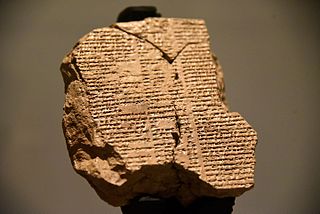
Mesopotamian mythology refers to the myths, religious texts, and other literature that comes from the region of ancient Mesopotamia which is a historical region of Western Asia, situated within the Tigris–Euphrates river system that occupies the area of present-day Iraq. In particular the societies of Sumer, Akkad, and Assyria, all of which existed shortly after 3000 BCE and were mostly gone by 400 CE. These works were primarily preserved on stone or clay tablets and were written in cuneiform by scribes. Several lengthy pieces have survived erosion and time, some of which are considered the oldest stories in the world, and have given historians insight into Mesopotamian ideology and cosmology.
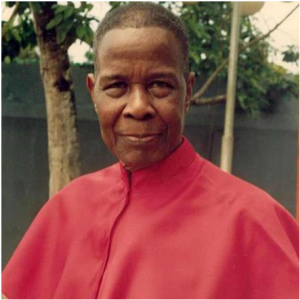
Olumba Olumba Obu (1918-2003?) is a Nigerian religious leader who is believed by followers to have been God in human form. He was the founder of the Brotherhood of the Cross and Star, an organization which has been described as a new religion.
References
- ↑ While Mount Olympus actually exists, the Greeks understood a distinction between the Olympus of the Gods and the part that could be seen by humans. See Dudley, John (1846), Naology: or, A treatise on the origin, progress, and symbolical import of the sacred structures of the most eminent nations and ages of the world, F. and J. Rivington, p. 22
- ↑ "Sumerian Mythology: Chapter IV. Miscellaneous Myths". www.sacred-texts.com. Retrieved 2022-07-06.
- ↑ Murray, Alexander (1897). Murray's Manual of Mythology. Philadelphia: Henry Altemus. p. 187.
- ↑ Chaturvedi, B. K. (2020). Srimad Bhagwat Puran. Diamond Pocket Books Pvt Ltd. p. 16. ISBN 978-81-288-2252-0.
- ↑ Lutgendorf, Philip (2007-01-11). Hanuman's Tale: The Messages of a Divine Monkey. Oxford University Press. p. 280. ISBN 978-0-19-804220-4.
- ↑ "The legend of the wandering Jew in Europe and in Romania".
- ↑ The Immortal by JJ Dewey
- ↑ 3 Nephi 28
- ↑ Storl, Wolf-Dieter (2004-09-14). Shiva: The Wild God of Power and Ecstasy. Simon and Schuster. p. 92. ISBN 978-1-59477-780-6.
- ↑ Mickaharic, Draja (2007-05-01). Immortality. Lulu.com. ISBN 978-1-4303-1751-7.
- ↑ "Mahavatar Babaji: The unknown 'immortal yogi'". India Today. Retrieved 2020-06-08.
- ↑ Obu, Olumba Olumba; Etteh, Solomon David (1992). He is the Father: Remain as Indefinable Spirit... in Olumba Olumba Obu (as Man, Spirit and Soul)... The Spiritual "Manifest" of the Past, Present and Future Plan of the Spiritual Case Studies (Book One). Everlasting Gospel Centre. ISBN 978-978-2175-48-9.
- ↑ Bassey, K. E. (1988). "I Am that I Am": Leader Olumba Olumba Obu, Sole Spiritual Head, Brotherhood of the Cross and Star. Brotherhood Press.
- ↑ "The Eternal Life of Gilgamesh". World History Encyclopedia . Retrieved 2020-06-09.
- ↑ Glancey, Jonathan. "The army that conquered the world". www.bbc.com. Retrieved 2020-06-09.